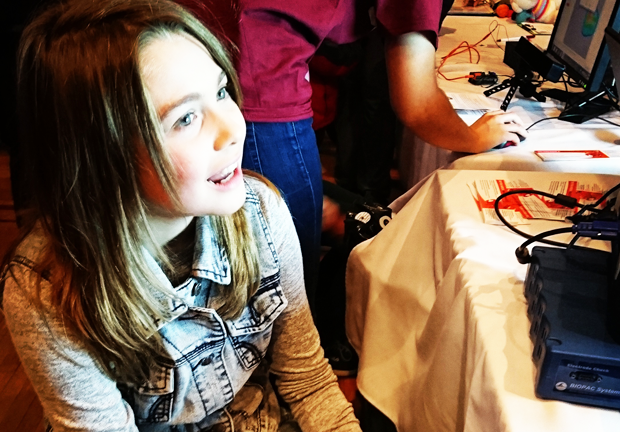'Children's eyes light up': Exposcience 2016 welcomes 1,800 visitors
 Photo by Elisabeth Faure
Photo by Elisabeth Faure
The 33rd edition of Concordia’s annual Exposcience delighted children and adults alike. Held on November 12 and 13 in Pointe-Claire’s Stewart Hall, the event offered close to 1,800 visitors the chance to participate in interactive scientific displays on topics ranging from the chemistry of ice cream to the effects of climate change on the planet.
“We always like to say Exposcience is for children aged one to 90,” says Miriam Posner, manager of planning and academic facilities for the Faculty of Arts and Science.
“When you see the children’s eyes light up as they explore the exhibitions, you really understand why we do this every year. It fosters a sense of fascination and promotes the value of community. It also demonstrates that Concordia is a leader when it comes to getting the next generation interested in science.”
‘A wonderful outreach’
Fellow organizer Cameron Tilson, assistant director in institutional planning and analysis, first became involved with Exposcience in 1984.
“It represents a wonderful outreach to our community,” he says.
“Our students are some of our best ambassadors. This event gives them an opportunity to talk about and demonstrate the work they are doing with members of the public.”
Tilson adds that over the years he’s spoken to numerous current and former Concordia students who insist that attending Exposcience was one of the reasons they entered their field of study and chose to attend the university.
Drones, dune buggies and electrocardiograms
Every year, new exhibitions are offered, and this year was no exception. Audiences got to take in a display featuring a newly purchased drone from the Department of Geography, Planning and Environment. It streamed pictures taken by a multi-spectral camera, which captures image data at specific frequencies across the electromagnetic spectrum.
Meanwhile, the Department of Psychology’s table featured three exhibitions: associate professor Jennifer McGrath showed individuals their heart beats using electrocardiograms; assistant professor Kristen Dunfield and her students demonstrated how developmental researchers approach testing in children, investigating issues such as the development of morality and theory of mind; and associate professor Aaron Johnson’s display included a game of Where’s Waldo to demonstrate eye tracking.
The Faculty of Engineering and Computer Science also joined in the fun. The Concordia SAE (Society of Automotive Engineers) display was once again a crowd favourite, allowing visitors to experience a rocky ride while strapped into a dune buggy. Meanwhile, students from the UAV Concordia (Unmanned Aerial Vehicle) student society allowed visitors to examine Aerial technology up close.
“It’s always rewarding to know we are fostering curiosity about science and technology,” says Posner.
Learn more about Concordia’s Faculty of Arts and Science.


